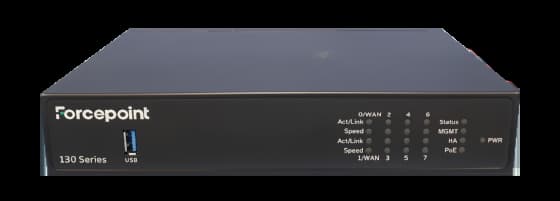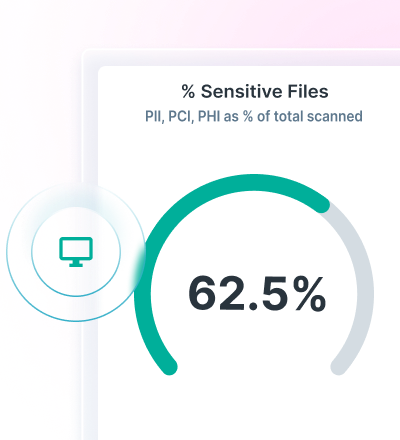
12,000명 이상의 고객이 잘못할 수 없습니다










































사무실, 지사 및 원격 위치에 대한 네트워크 액세스를 확장하고 보안을 강화합니다.
광역 네트워킹과 보안이 만났습니다. Forcepoint Secure SD-WAN은 전 세계 어디서나 우수한 연결성을 유지하면서 제로 트러스트 보안 제어를 통해 첨단 위협으로부터 네트워크를 보호합니다.
Forcepoint Secure SD-WAN을 선택해야 하는 이유
중앙 집중식 관리: 클라우드에서 지사, 사무실 및 원격 위치를 활성화합니다. 정책을 한 번 구성하고 SMC(Secure Management Console)로 제로터치 배포를 사용합니다.
애플리케이션 성능 향상: Multi-Link 연결, 동적 트래픽 스티어링, 애플리케이션 상태 모니터링 및 기타 기능을 통해 대기 시간과 지터를 줄이고 중요 애플리케이션이 대역폭 우선 수신하도록 보장합니다.
첨단 위협으로부터 보호: 다계층 검사, 침입 방지, DNS 싱크홀딩 등을 사용하여 위험을 탐지하고 방지하며, ZTNA 애플리케이션 커넥터를 통해 현장에서나 원격으로 애플리케이션에 대한 접근을 보호합니다.
운영 비용 절감: 로컬 ISP 광대역 및 사설 MPLS 선택항목을 실시간으로 혼합하고 매칭하여 네트워킹 비용을 절감하고 신뢰성을 증진할 수 있습니다.
데이터시트
어플라이언스 모델 비교


Global Network
20+
Countries
45+
Cluster Nodes
Clustering In a Way No One Else Can Do
Christian Keller, CISO at Huber + Suhner, lists reliability, clustering, and ability to navigate global compliance requirements among the top benefits of Forcepoint NGFW.
Forcepoint Secure SD-WAN 모델 살펴보기

350 시리즈
원격 사이트 및 지사(데스크탑 디자인)에 적합합니다.
최대 13개의 인터페이스
40Gbps의 방화벽 처리량
2Gbps(N352) 또는 4.1Gbps(N355)의 IPS NGFW 처리량

130 시리즈
Ideal for remote offices, branches and stores.
최대 8개의 인터페
이스, 최대 8 Gbps
IPS 최대 1,600 Mbps의 NGFW 처리량
클라우드 이미지:
- 통합 Forcepoint NGFW 소프트웨어
- Amazon Web Services (AWS)
- Microsoft Azure Solutions
- 클라우드 안팎의 노스-사우스 통신과 SDN 이스트-웨스트 트래픽을 모두 보호
가상 어플라이언스:
- 통합 Forcepoint NGFW 소프트웨어
- KVM과 VMware ESXi 및 NSX에 사용 가능
- 64개의 CPU로 확장 가능
- 네트워크 마이크로세그멘테이션 자동화
- 물리적 방화벽과 클러스터링 가능


Secure SD-WAN 구매자 가이드
이 안내서에는 첫 구매자와 업그레이드를 고려하는 고객 모두에게 해당되는 Secure SD-WAN 솔루션 평가의 핵심 기준이 나와 있습니다. 주로 고려해야 할 다섯 가지 사항을 알아보세요.
고객이 SD-WAN을 선택하는 이유
고객이 SD-WAN을 선택하는 이유
"Our costs - both for the project and maintenance - are going down because we don't need resources locally, we have centralized everything. If we want new service on a train, we define the policy then give the hardware to the operator, who installs it."
VR 그룹
Frequently Asked Questions
What is managed SD-WAN?
A managed SD-WAN is a service where a provider handles the deployment, configuration, monitoring and optimisation of your WAN. Meanwhile, a cloud-managed SD-WAN adds centralised control via the cloud, making it easier to apply consistent policies, improve performance and maintain security across distributed networks without internal resource strain. Learn more about this product through our comprehensive managed SD-WAN solutions guide.
What are the benefits of SD-WAN?
Benefits of Forcepoint Secure SD-WAN include the following:
Centralized management
Improved application performance
Protection against advanced threats
Reduced operating costs
How much does SD-WAN cost?
SD-WAN costs are determined by factors, including the type of deployment, the size of the network, the number of locations to connect, the type and amount of data transiting the network and any existing infrastructure that may be leveraged when deploying an SD-WAN solution.
What is SD-WAN security?
SD-WAN security helps organizations enable effortless connection to cloud resources while protecting users, data and IT environments from attack.
What is an SD-WAN solution?
Ad SD-WAN solution applies software-defined networking principles to the wide area network.
What is an SD-WAN provider?
SD-WAN providers enable organizations to deploy SD-WAN technology.
What is an SD-WAN appliance?
SD-WAN appliances are physical or virtual controllers located on-premises or in the cloud that connect an organization’s users to applications, services and workloads.
How do SD-WAN appliances work?
SD-WAN appliances and products are designed to overcome the challenges of ensuring fast and secure connectivity for branch locations and hybrid workforces. The traditional wide area network uses a hub-and-spoke model that requires all traffic to flow through a central data center. For organizations with a highly distributed workforce, this model adds unacceptable levels of latency that negatively affect user experiences and productivity. Additionally, legacy WANs are built with costly Multiprotocol Label Switching (MPLS) connections that are time-consuming to manage and deploy, preventing organizations from scaling easily and cost-efficiently. SD-WAN overcomes these issues by creating a virtual overlay for the network that abstracts network connections and enables the use of additional, low-cost transport services that add redundancy and flexibility.
What is Multiprotocol Label Switching (MPLS)?
Multiprotocol Label Switching (MPLS) is data forwarding technology that increases the speed and controls the flow of network traffic.
What is SD-WAN vs MPLS?
SD-WAN is a networking technology that uses software to make wide area networks more intelligent and flexible by connecting sites directly to the internet over commodity broadband links. Configurations and access policies are centrally managed and easily applied across all sites, removing the need to manual administer each WAN device individually. MPLS is data forwarding technology for network traffic that directs data through a path via labels instead of requiring complex lookups in a routing table at every stop. Traditional networking technology, MPLS, has seen competition from SD-WAN solutions to meet today's high demands and expanding needs for networked business-critical systems.
















